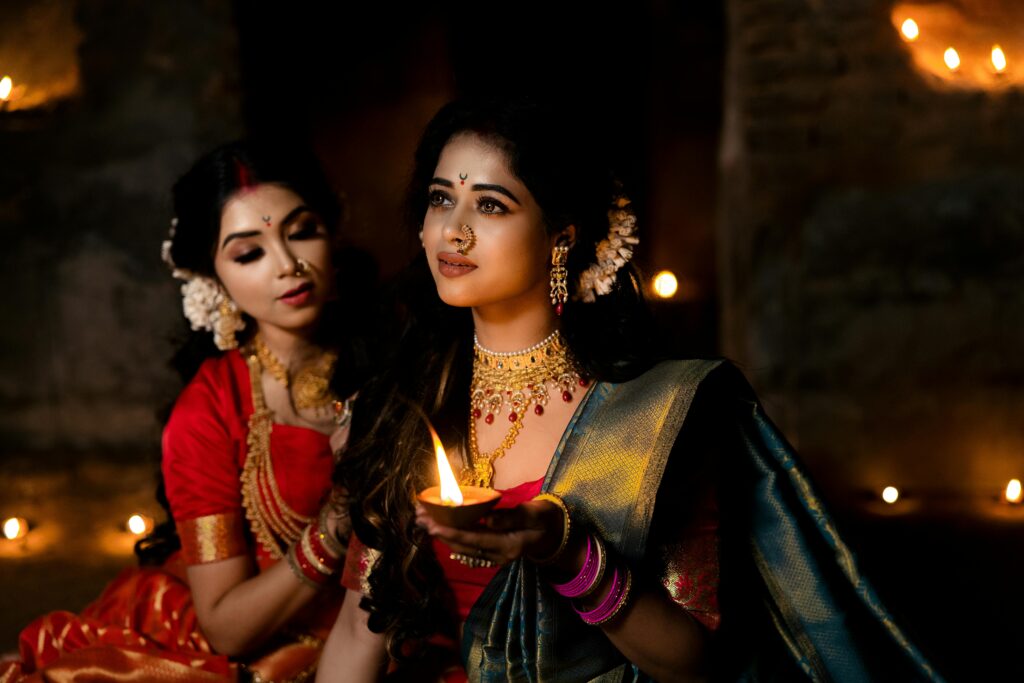Indian Traditional Dressing






Indian traditional dressing has a rich and varied history, reflecting the country’s diverse cultures, climates, and historical influences. Each region in India boasts a distinct style of attire, which has evolved over centuries, shaped by religion, social status, climate, and contact with foreign cultures. Let’s explore the evolution of traditional Indian clothing and its cultural significance.
Ancient Beginnings: The Roots of Indian Clothing:
The earliest evidence of Indian clothing dates back to the Indus Valley Civilization (around 2500 BCE). Archaeological findings, including terracotta figurines, depict men wearing a simple draped garment around their waists, akin to the modern dhoti, while women wore saree-like drapes. These garments were often made of cotton, cultivated in the region, and dyed using natural pigments.
The Vedic period (1500–500 BCE) introduced more structured clothing, with references in ancient texts to garments like the antariya (a lower garment), uttariya (a cloth draped over the shoulders), and stanapatta (a chest band for women). Jewelry and accessories, such as bangles, earrings, and necklaces, also became integral to dressing.
Medieval India: Influence of Dynasties and Cultures:
With the advent of new dynasties and cultures, Indian fashion began to diversify further. During the Mauryan and Gupta periods (322 BCE–550 CE), intricate weaving techniques and fine fabrics like silk became popular. Clothing styles often reflected social status, with royalty and the wealthy adorning themselves with luxurious materials and ornate jewelry.
The arrival of the Mughals in the 16th century marked a turning point in Indian dressing. Mughal emperors introduced Persian influences, leading to the creation of iconic garments like the sherwani, achkan, and lehenga choli. The Mughal period also saw the rise of zari (gold thread embroidery), fine muslin, and brocade fabrics, which became hallmarks of Indian traditional attire.
Colonial Era: Blending of East and West:
The British colonial period (1757–1947) brought significant changes to Indian clothing. Western-style outfits like trousers, shirts, and gowns were adopted by many, particularly in urban areas. However, traditional attire like the saree, salwar kameez, and kurta pajama remained integral to daily life and cultural identity. This era also saw the popularization of handloom fabrics like khadi, championed by Mahatma Gandhi as a symbol of resistance against British rule.
Post-Independence and Modern Trends:
After India gained independence in 1947, traditional dressing experienced a revival, with increased pride in indigenous textiles and crafts. Designers began incorporating ancient techniques like block printing, tie-dye, and embroidery into contemporary fashion. Today, India’s traditional attire reflects a blend of modern aesthetics and historical richness.
Regional Styles: A Tapestry of Traditions:
- North India: The saree, salwar kameez, and lehenga choli dominate, with regional variations like the Banarasi saree and phulkari embroidery.
- South India: Kanjeevaram sarees, made from luxurious silk, are iconic, alongside garments like the lungi and mundu.
- East India: Assam’s mekhela chador, Bengal’s white-and-red sarees, and Odisha’s ikat fabrics are famous.
- West India: Gujarat’s bandhani textiles, Rajasthan’s vibrant ghagras, and Maharashtra’s nauvari sarees showcase the region’s diverse styles.
Cultural Significance:
Indian traditional clothing is deeply intertwined with rituals, festivals, and life events. Each outfit carries symbolic meanings, with colors, patterns, and styles chosen to reflect joy, reverence, or mourning. For instance, red symbolizes auspiciousness in bridal wear, while white is traditionally worn at funerals.
Global Influence:
Today, Indian traditional attire has gained global recognition. Designers incorporate Indian textiles and patterns into international fashion, while Bollywood films popularize sarees and lehengas worldwide. Indian diaspora communities also continue to wear and celebrate traditional outfits, preserving their heritage abroad.
Indian traditional dressing is more than just clothing—it is a celebration of the country’s history, diversity, and artistic heritage. From ancient drapes to intricate lehengas, each garment tells a story of cultural evolution, craftsmanship, and identity. As modernity embraces tradition, Indian clothing remains a vibrant testament to the country’s timeless charm and creativity.

